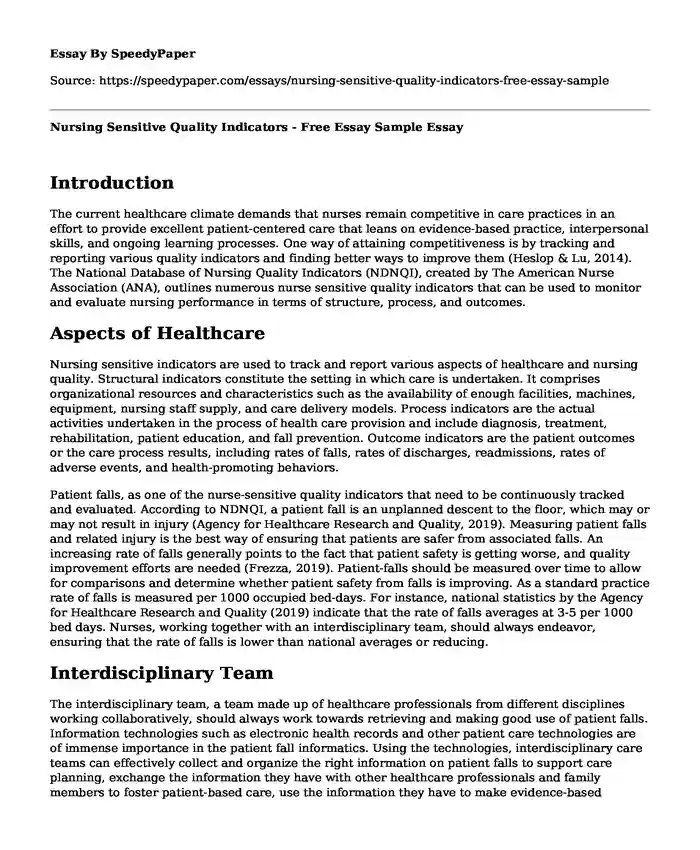
| Type of paper: | Essay |
| Categories: | Nursing Healthcare |
| Pages: | 3 |
| Wordcount: | 672 words |
Introduction
The current healthcare climate demands that nurses remain competitive in care practices in an effort to provide excellent patient-centered care that leans on evidence-based practice, interpersonal skills, and ongoing learning processes. One way of attaining competitiveness is by tracking and reporting various quality indicators and finding better ways to improve them (Heslop & Lu, 2014). The National Database of Nursing Quality Indicators (NDNQI), created by The American Nurse Association (ANA), outlines numerous nurse sensitive quality indicators that can be used to monitor and evaluate nursing performance in terms of structure, process, and outcomes.
Aspects of Healthcare
Nursing sensitive indicators are used to track and report various aspects of healthcare and nursing quality. Structural indicators constitute the setting in which care is undertaken. It comprises organizational resources and characteristics such as the availability of enough facilities, machines, equipment, nursing staff supply, and care delivery models. Process indicators are the actual activities undertaken in the process of health care provision and include diagnosis, treatment, rehabilitation, patient education, and fall prevention. Outcome indicators are the patient outcomes or the care process results, including rates of falls, rates of discharges, readmissions, rates of adverse events, and health-promoting behaviors.
Patient falls, as one of the nurse-sensitive quality indicators that need to be continuously tracked and evaluated. According to NDNQI, a patient fall is an unplanned descent to the floor, which may or may not result in injury (Agency for Healthcare Research and Quality, 2019). Measuring patient falls and related injury is the best way of ensuring that patients are safer from associated falls. An increasing rate of falls generally points to the fact that patient safety is getting worse, and quality improvement efforts are needed (Frezza, 2019). Patient-falls should be measured over time to allow for comparisons and determine whether patient safety from falls is improving. As a standard practice rate of falls is measured per 1000 occupied bed-days. For instance, national statistics by the Agency for Healthcare Research and Quality (2019) indicate that the rate of falls averages at 3-5 per 1000 bed days. Nurses, working together with an interdisciplinary team, should always endeavor, ensuring that the rate of falls is lower than national averages or reducing.
Interdisciplinary Team
The interdisciplinary team, a team made up of healthcare professionals from different disciplines working collaboratively, should always work towards retrieving and making good use of patient falls. Information technologies such as electronic health records and other patient care technologies are of immense importance in the patient fall informatics. Using the technologies, interdisciplinary care teams can effectively collect and organize the right information on patient falls to support care planning, exchange the information they have with other healthcare professionals and family members to foster patient-based care, use the information they have to make evidence-based decisions, and negotiate the course of care (Grove et al., 2015). The right information on patient falls also helps determine the necessity of staff and patient education to limit fall events. The team also undertakes post-fall reviews as an opportunity to plan towards preventing the reoccurrences of similar cases.
Conclusion
In conclusion, reducing patient-falls is a critical goal that every nurse and any other healthcare practitioner should pursue. Addressing falls calls for healthcare professionals' need to work in teams rather than individually for patient safety to be attained. Each professional should be willing to collect and share information they have concerning patient falls to support care plans and prevent reoccurrences. Technological integration is a good avenue to promote efforts to reduce patient falls through evidence-based practice leading to improved communication between nurses and other clinicians, reduced rates of falls, greater abilities to undertake comparisons and enhance patient-centered care.
References
Agency for Healthcare Research and Quality. (2019, September 7). Falls. PSNet.
https://psnet.ahrq.gov/primer/falls
Frezza, E. E. (2019). Fall prevention—Engaging the family. Patient-Centered Healthcare, 215-219.
https://doi.org/10.4324/9780429032226-29
Grove, S. K., Burns, N., & Gray, J. (2015). Understanding nursing research: Building an evidence-based practice. Elsevier Health Sciences.
Heslop, L., & Lu, S. (2014). Nursing-sensitive indicators: A concept analysis. Journal of Advanced Nursing, 70(11), 2469-2482.
https://doi.org/10.1111/jan.12503
Jones, T. (2016). Outcome measurement in nursing: Imperatives, ideals, history, and challenges. OJIN: The Online Journal of Issues in Nursing, 21(2), 1-11.
https://doi.10.3912/OJIN.Vol21No02Man01.
Cite this page
Nursing Sensitive Quality Indicators - Free Essay Sample. (2023, Nov 26). Retrieved from https://speedypaper.net/essays/nursing-sensitive-quality-indicators-free-essay-sample
Request Removal
If you are the original author of this essay and no longer wish to have it published on the SpeedyPaper website, please click below to request its removal:
- Free Essay on Deviance and Crime
- Research Analysis Essay Sample: End-of-life Decision-Making in Nursing
- Free Essay: Communication Skills in Nursing. EBP Change Proposal.
- Paper Example. Description of The Pathology
- Essay Sample on Functions of the Lymphatic System
- Nurse Practitioner Roles: Training, ANA Guidelines, & Patient Care - Essay Sample
- Is Vaping with e-Cigarettes Safe? - Essay Sample
Popular categories




